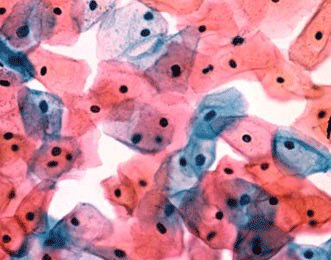Univesity of California San Francisco (UCSF) scientists have shown for the first time that the rigidity of a tissue can induce cancer. The research team identified an enzyme that is crucial for regulating tissue stiffness and demonstrated that the enzyme can turn abnormal but non-malignant breast tissue into tumors, according to a study published in “Cell” online.
 Blocking the enzyme lysyl oxidase (LOX) decreased tissue stiffness and reduced the chance a tumor would form. It also caused tumors that did develop to be smaller and less aggressive, said senior author Valerie Weaver, PhD, associate professor and director of the Center for Bioengineering and Tissue Regeneration in the Department of Surgery at the University of California, San Francisco.
Blocking the enzyme lysyl oxidase (LOX) decreased tissue stiffness and reduced the chance a tumor would form. It also caused tumors that did develop to be smaller and less aggressive, said senior author Valerie Weaver, PhD, associate professor and director of the Center for Bioengineering and Tissue Regeneration in the Department of Surgery at the University of California, San Francisco.
Study findings appear online athttp://www.cell.com/abstract/S0092-8674(09)01353-1
“Our study shows how stiffening of the breast tissue that is controlled by enzymes such as LOX is a key process that regulates cancer development,’’ said Weaver. “These findings suggest that any factor that increases the stiffness in a tissue could promote cancer. The most compelling finding of the study is that the research team identified enzymes that regulate tissue stiffening—opening up the possibility for the development of targeted therapies. The enzyme triggers a clear physical change in breast tissue and, if we could stop this happening, we expect it would prevent cancers from progressing and hopefully also prevent tumor metastasis which is the leading cause of patient mortality.’’
The supportive tissue surrounding cancer cells is shaped differently than healthy tissue and is stiffer and more fibrous. These properties help doctors detect breast cancers, but until now scientists have not appreciated that these physical changes actually control tumor development and no one has yet identified factors that regulate these modifications, according to Weaver.
In the current study, the team found that the LOX enzyme caused many of the structural changes in collagen, the major component of the supportive tissue, to change in a process known as cross-linking, which makes the tissue more fibrous. When the team used chemicals or an antibody to block LOX, they found collagen in the mammary glands contained fewer cross-links and the tissue was less fibrous and softer, said Weaver. Most important, they found fewer and smaller tumors had formed in breast tissue and the tumors that did form were less aggressive.
The study results clearly demonstrate that LOX activity increases collagen cross-linking to stiffen the tissue, and that it is the stiffness that drives the pre-cancerous cells to turn into invasive tumors, Weaver emphasized.
The study results - reported in “Cell’’- build upon earlier work conducted by Weaver and colleagues that implicated integrins (receptors that help mediate attachment between a cell and surrounding tissue) as signaling molecules that play an important role in directing the cancerous behavior of a tissue. The findings also suggest why human tumors that are typically stiffer than normal tissue so often have high integrin activity.
Although the tests were carried out in breast cancer, Weaver said there is compelling evidence from her group and others that suggest a similar mechanism likely operates in many other cancers. For instance, pancreatic tumors are notoriously very rigid and highly aggressive. Weaver and colleagues recently found that pancreatic tumors have high levels of LOX in their connective tissue (stroma).
The unique perspective of the UCSF study is that it showed the cells within the connective tissue surrounding the growing tumors express the LOX enzyme, said Weaver. These cells induce the tissue stiffening and fibrosis that through mechanical forces, promote tumor cells to become invasive. These observations emphasize the need to treat tumors early and to focus on the tissue microenvironment – not just the tumor but the surrounding area as well.
“This study may also help explain why the rate of breast cancer increases dramatically with age – aged tissues are stiffer and contain higher levels of abnormal collagen cross-links,’’ said Weaver. “I’m cautiously optimistic. We still have a lot more work to do, but this is certainly exciting.’’
Further testing established other factors that could be acting in combination with LOX, including cancer genes such as ErbB2 and other molecules including PI3kinase. Weaver said the study shows that cancer is best viewed as a complex process of changes in tissue remodeling that is tightly controlled by many biochemical and mechanical factors.